New Formulation Provides Unsurpassed
Fuel Economy and Performance
Slide Show https://admin.acrobat.com/_a726231480/pi/
Today’s fuels vary in quality and additive treat levels from
the refinery. Although a certain level of detergent additive is required by law
to be formulated into gasoline, cost restrictions cause refineries to use low
quality additives in the lowest additive concentration (LAC), a level
insufficient to prevent deposit accumulation. Deposits accumulate on fuel
injectors, intake valves and combustion chambers within just a few thousand
miles, disrupting spray patterns, affecting electronic sensors and causing a
multitude of problems. Fuel system deposits result in the following:
-
Lost fuel economy
-
Lost power and poor throttle response
-
Failed emission tests
-
Poor drivability - surging, hesitation, stalling, rough idle
-
Engine knocking (pinging) and rap
-
Difficult starts
 The
newly formulated AMSOIL PI Performance Improver is the most potent gasoline
additive available today. As a concentrated detergent, it is unsurpassed
in cleaning combustion chamber deposits, intake valve deposits and port
fuel injector deposits, eliminating the need for expensive fuel injector
cleaning procedures. It is ideal for use prior to emissions inspections, and it
helps maintain peak engine efficiency, fuel economy, power and drivability in
newer low mileage engines. In engines with accumulated deposits, testing showed
AMSOIL PI provided the following clean-up benefits after only one tank of
gasoline:
The
newly formulated AMSOIL PI Performance Improver is the most potent gasoline
additive available today. As a concentrated detergent, it is unsurpassed
in cleaning combustion chamber deposits, intake valve deposits and port
fuel injector deposits, eliminating the need for expensive fuel injector
cleaning procedures. It is ideal for use prior to emissions inspections, and it
helps maintain peak engine efficiency, fuel economy, power and drivability in
newer low mileage engines. In engines with accumulated deposits, testing showed
AMSOIL PI provided the following clean-up benefits after only one tank of
gasoline:
-
Improves fuel mileage an average of 2.3% and up to 5.7%
-
Reduced emissions
-
hydrocarbons (HC) up to 15%
-
carbon monoxide (CO) up to 26%
-
nitrous oxides (NOx) up to 17%
-
Restored power and performance
-
Reduced need for costly higher octane fuel
-
Reduced noise from carbon rap and pre-ignition
-
Better drivability
-
Smoother operation
The new PI formulation offers greater potency than the old
formulation and delivers extra benefits, including increased fuel economy
improvements, improved intake valve and combustion chamber cleaning and lower
emissions. Because it is recommended every 4,000 miles, rather than with every
tank of gas, the new PI formulation is also more convenient to use. Its new
smaller neck makes it easier to pour into the tank, and because the flip top has
been eliminated, leakage is minimized.
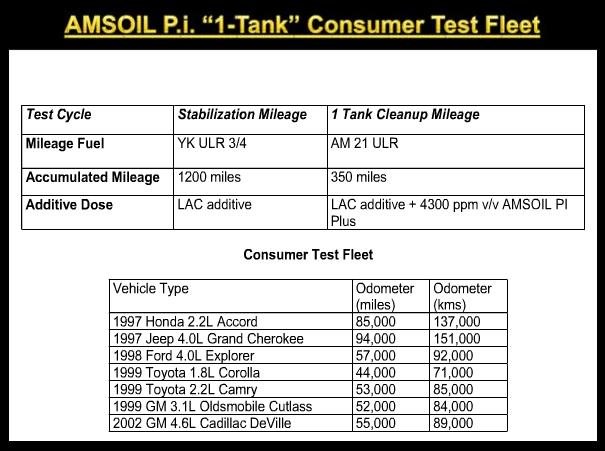
Unsurpassed Deposit Clean-up
Port fuel injector deposits form after the engine has been shut
down and there is no gasoline flowing through the injectors. During this “hot
soak” period the injectors heat up and the gasoline remaining in the injectors
degrades and forms deposits. This can happen very quickly with the use of poor
quality gasoline and short trip driving. Because the clearances within the
injectors are extremely tight and injectors must deliver precise amounts of “atomized”
fuel, even small amounts of deposits can cause injectors to malfunction. Fuel
flow is reduced and spray patterns are disrupted, decreasing engine efficiency,
power and fuel economy, while increasing exhaust emissions.
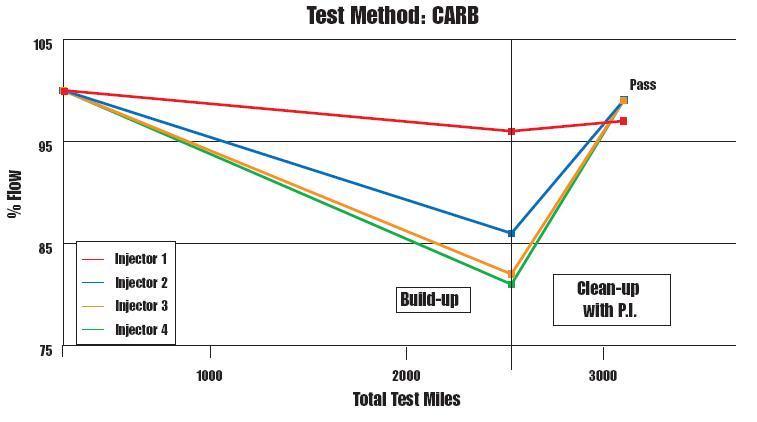
Two of the four dirty injectors tested were fouled >15% and
another was fouled >10%. After one tank of operation on AMSOIL PI, all
injectors returned to >95% flow.

Intake valve deposits form on the intake side or back side of
the valves. As deposits increase, they restrict airflow and alter airflow
patterns in the cylinder. The deposits disrupt the balanced air/fuel ratio by
momentarily absorbing and releasing fuel, and they can cause valve sticking by
getting in the way of the valve stem and guide. Deposits also restrict proper
seating, and the valves may be burned. Intake valve deposits cause lost engine
power, increased emissions, poor engine efficiency and potential valve failure.
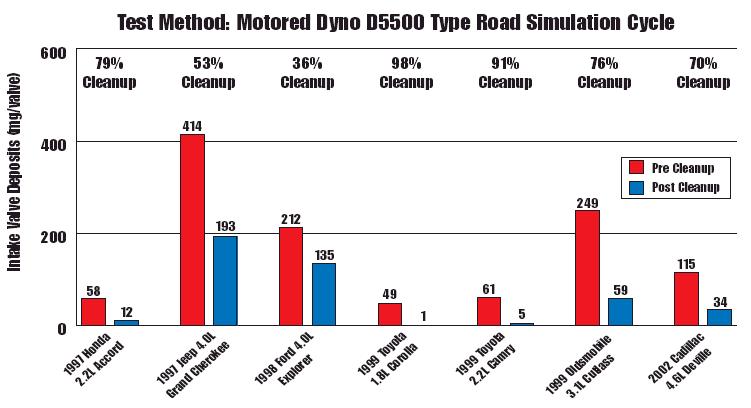
AMSOIL PI averaged 72% intake valve deposit cleanup across a
wide range of engine types and sizes, with two cars cleaning up greater than
90%.
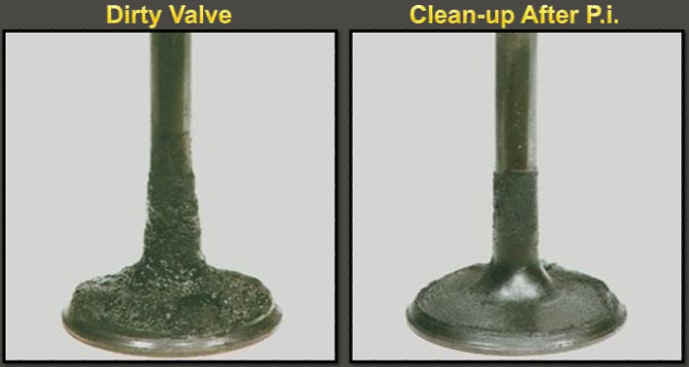
Combustion chamber deposits form on the top of the pistons and
on the cylinder heads. They increase compression and absorb heat during
combustion to later release it during the intake cycle. In some engines with
tight squish domes, combustion chamber deposits cause the piston to hit the
cylinder head. This is referred to as combustion chamber deposit interference or
“carbon rap.” Combustion chamber deposits also flake off as they get large,
and these flakes can get trapped between the valves and valve seat, resulting in
compression loss, difficult starting and rough idle.
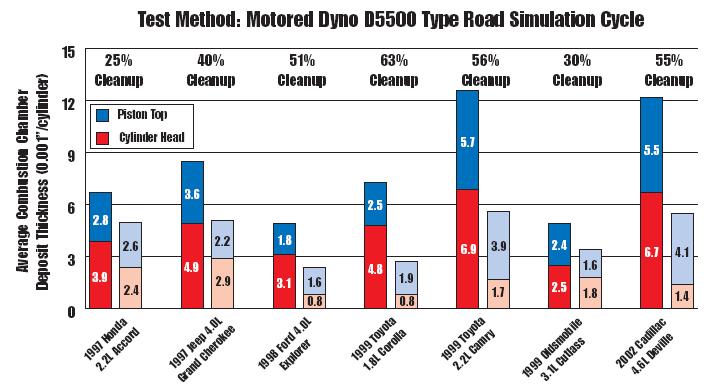
AMSOIL PI averaged 46% combustion chamber deposit cleanup across
a wide range of engine types and sizes, with four cars cleaning up greater than
50%.
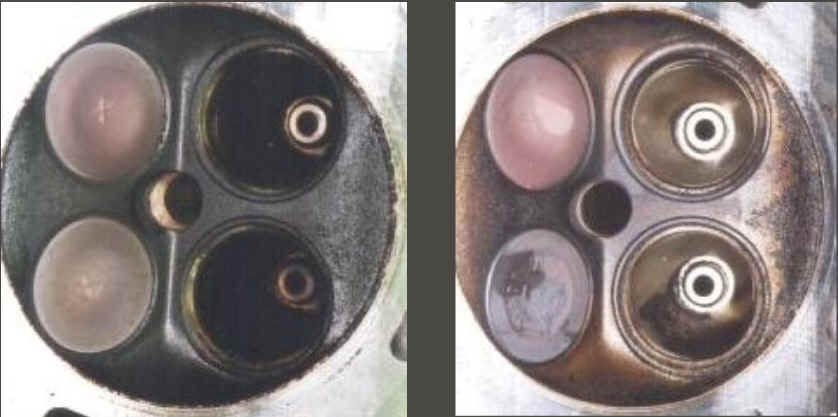 |
|
Combustion chamber before
PI treatment. |
Combustion chamber after
PI treatment. |
Higher compression and stored heat cause increased intake fresh
charge temperatures and the increased likelihood of pre-ignition “knock” or
“pinging” when the fuel spontaneously combusts prior to spark ignition. This
increases emissions and may cause engine damage. Many of today’s cars have “knock”
sensors that adjust spark timing to prevent knock. Although audible knock is
controlled, power is lost from retarded timing. Higher octane fuels of 4-5
octane numbers can be used to help prevent knock, an effect called “octane
requirement increase.” As a vehicle ages, more expensive higher octane fuel is
needed to keep it operating at peak performance. By cleaning combustion chamber
deposits, knock is controlled, power is restored, fuel economy increases and
higher octane fuels are less necessary for peak performance.
Maximum Fuel Economy
AMSOIL PI maximizes fuel efficiency by dissolving and removing
fuel system deposits and other contaminants for improved power and overall
performance.
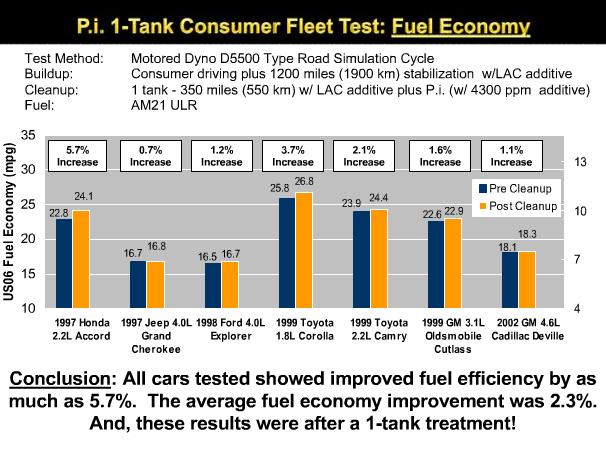
AMSOIL PI provided an average fuel efficiency increase of
2.3%, with one car showing improved fuel efficiency of 5.7%.
Although the new PI formulation costs slightly more per bottle
than the old formulation, its more powerful potency saves money in the long run.
For example, in a vehicle with a 20-gallon tank receiving 20 miles per gallon,
the new PI costs 15% less over the course of 4,000 miles. The old PI formulation
treated fuel at a rate of one oz. per 10 gallons of gasoline. A vehicle
receiving 20 mpg consumes 200 gallons of gas and 20 ounces of the old PI over
4,000 miles. Similarly, only one 12-oz.
bottle of new PI is recommended per 4,000 miles of driving.
Additionally, old PI required an initial clean-up dose of six ounces per 10
gallons of gas, further increasing its cost. Owners of vehicles receiving less
than 20 mpg save even more by using the new PI formulation.
PI Product Improvements
-
Unsurpassed combustion chamber clean-up
-
Increased fuel economy improvement
-
More powerful cleaning agents for better overall performance
Not just for Injectors
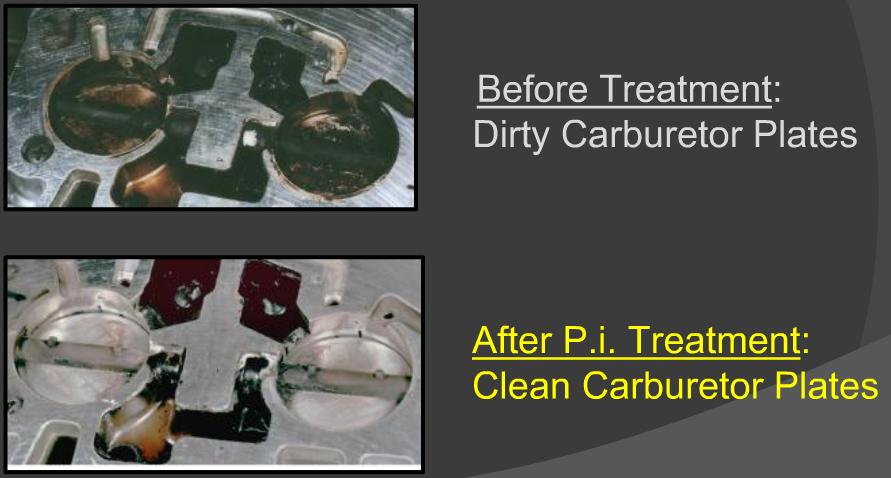
New Recommendations
Treat one full tank of gas every 4,000 miles or 100 hours of
service. One bottle treats 20 gallons of gas. Do not treat and run more than 40
gallons of gas per treatment. PI helps pass emissions tests. Treat gas, run that
tank and fill up again prior to test. Safe for use with catalytic converters,
oxygen sensors, oxygenated gas and 10% ethanol blended gas. Ideally, PI should
be poured into the tank prior to filling it with gas, but it will also mix
thoroughly when added after fill-up through normal agitation from driving.
Back
Report problems to Webmaster
 The
newly formulated AMSOIL PI Performance Improver is the most potent gasoline
additive available today. As a concentrated detergent, it is unsurpassed
in cleaning combustion chamber deposits, intake valve deposits and port
fuel injector deposits, eliminating the need for expensive fuel injector
cleaning procedures. It is ideal for use prior to emissions inspections, and it
helps maintain peak engine efficiency, fuel economy, power and drivability in
newer low mileage engines. In engines with accumulated deposits, testing showed
AMSOIL PI provided the following clean-up benefits after only one tank of
gasoline:
The
newly formulated AMSOIL PI Performance Improver is the most potent gasoline
additive available today. As a concentrated detergent, it is unsurpassed
in cleaning combustion chamber deposits, intake valve deposits and port
fuel injector deposits, eliminating the need for expensive fuel injector
cleaning procedures. It is ideal for use prior to emissions inspections, and it
helps maintain peak engine efficiency, fuel economy, power and drivability in
newer low mileage engines. In engines with accumulated deposits, testing showed
AMSOIL PI provided the following clean-up benefits after only one tank of
gasoline:







